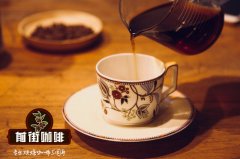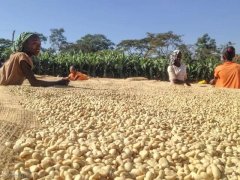How do you brew Harald coffee? can Harald coffee be made with milk? what's the difference in flavor?

Professional coffee knowledge exchange more coffee bean information please follow the coffee workshop (Wechat official account cafe_style)
Ethiopia produces very complex coffee, so there are different growing areas and varieties that produce unique and unique characteristics in the coffee they process-Harald coffee from natural simplicity and wine, Lekempti's interesting tropical fruit, plum and wine Djimmah, chocolate-driven Limou, berry injection Sidamo, wild fruit bench. With elegant Yirgacheffe classic hues-the best examples of all coffee and Africa from these different Ethiopian regions.
Haller is one of the oldest and most respected sources of coffee in Ethiopia. The variety is called a family heirloom, and compared with coffee raised in other countries, these coffees are exquisite coffee with low crop yields.
Harald's tragedy is a story of declining numbers.
Extreme weather brought about by global climate change has adversely affected the growth conditions of coffee in the region-prolonged drought is reducing the nutritional level of coffee trees, flowering and so on.
I remember 10 years ago, it was more common for Harald coffee to have beautiful blueberry notes. It is rare these days.
All Harald coffee is processed naturally.
This means that the appearance of roasted coffee is uneven, the screen size is the same, and it is perfectly normal as part of the unique and unique charm of Harar coffee.
Almost every Harar has a wild fruit element, so Harar may not be suitable for lighter filtered coffee, such as pouring, air processing, cold brewing, etc. This fashionable element may be dirtier than other Ethiopians. Such as washed Yirgacheffe,Sidamo and Limou.
The best places for Harar to enter it are plain coffee and espresso with milk.
This is a strange kind of coffee and raw beans. Its aroma with aromas of sun-dried coffee, cherries and sweet grains is not uncommon among selected Ethiopian sun-treated beans. Some slight color inconsistencies cause it to be rated level 4, which is a low grade in sun-cured boutique coffee. Some quakers beans are produced during baking. The bean shape is small and long, the water activity is stable, dry, and has an astonishingly low density. It won't be an easy-to-bake coffee bean, but it's worth a try.
The drying of Harald coffee with whole coffee cherries is a traditional coffee treatment in Ethiopia. Whether you call it solarization, drying, fruit drying or cherry drying, this "zero treatment" of coffee after harvest can be traced back to Ethiopia. Today, curry farmers around the world still use this way of processing coffee like raisins, all from here. Throughout Ethiopia, it is still common for small farmers to dry their crops on porches or lawns.
Important Notice :
前街咖啡 FrontStreet Coffee has moved to new addredd:
FrontStreet Coffee Address: 315,Donghua East Road,GuangZhou
Tel:020 38364473
- Prev

What is the special flavor of Harald coffee? where is the price of Harald coffee produced in Ethiopia?
Professional coffee knowledge exchange more coffee bean information please follow the coffee workshop (Wechat official account cafe_style) Ethiopia was the first country to teach me what regional and wide differences mean to cups. As I walk along my own path, it helps me teach my coffee taste, I think, no matter where I am now. Harald Coffee
- Next

How are Ethiopian coffee beans graded? What's the difference between G1 and G3?
Professional coffee knowledge exchange more coffee bean information Please pay attention to the coffee workshop (Wechat official account cafe_style) often see Essel beans packaging written on what G1, G2, G3, what do these represent? What is the difference between them? The grading of Ethiopian coffee beans first of all, the Ethiopian Ministry of Agriculture has a person called CLU (Cupping and Liquoring Unit).
Related
- Beginners will see the "Coffee pull flower" guide!
- What is the difference between ice blog purified milk and ordinary milk coffee?
- Why is the Philippines the largest producer of crops in Liberia?
- For coffee extraction, should the fine powder be retained?
- How does extracted espresso fill pressed powder? How much strength does it take to press the powder?
- How to make jasmine cold extract coffee? Is the jasmine + latte good?
- Will this little toy really make the coffee taste better? How does Lily Drip affect coffee extraction?
- Will the action of slapping the filter cup also affect coffee extraction?
- What's the difference between powder-to-water ratio and powder-to-liquid ratio?
- What is the Ethiopian local species? What does it have to do with Heirloom native species?

